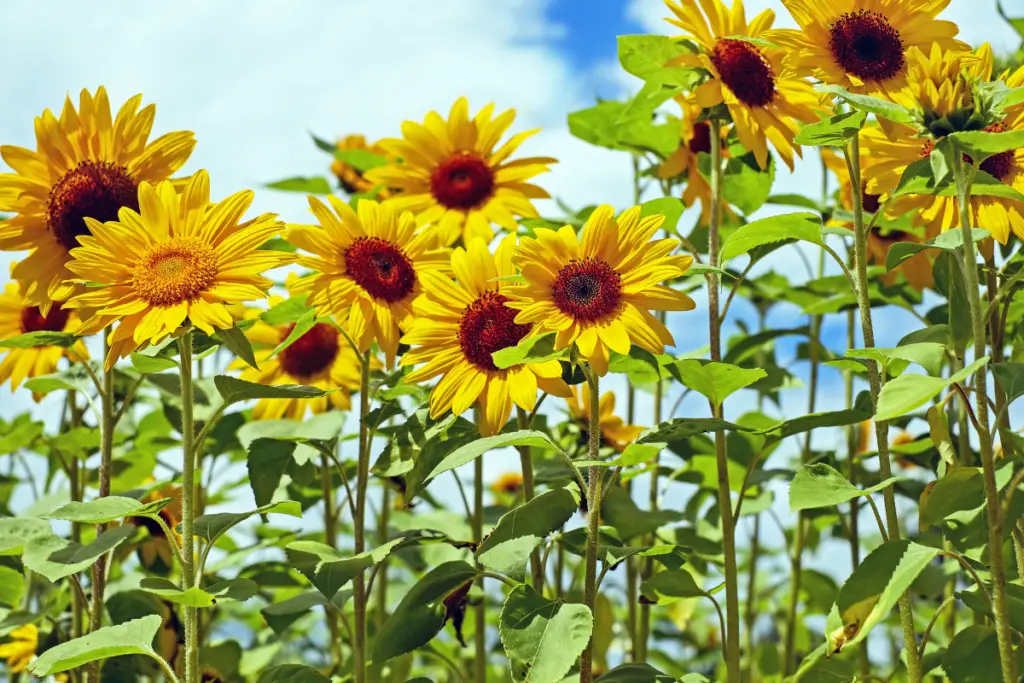Sunflowers are one of the most popular and recognizable flowers in the world. Known for their bright yellow petals and towering height, they are a favorite of gardeners and farmers alike.
In this article, readers will find a complete guide to growing sunflowers, including tips for planting, caring for, and harvesting these beautiful flowers.
To start, it is important to choose the right location for planting sunflowers. According to Garden Design, sunflowers require a sunny location with well-drained soil.
It is also helpful to plant them in groups to support each other against strong winds and rain. Once planted, sunflowers require regular watering, especially during hot and dry weather.
As the sunflowers grow, it is important to provide them with enough space to thrive. The Old Farmer’s Almanac recommends thinning the seedlings once they hit 6 inches tall, leaving the strongest plants about 12 inches apart.
Staggering planting is also recommended to ensure continuous blooms throughout the growing season.
With the right care and attention, anyone can grow beautiful and healthy sunflowers in their garden or farm.

Table of Contents
Understanding Sunflowers
Types of Sunflowers
There are many different types of sunflowers, each with its own unique characteristics.
Some of the most popular types include:
- Giant sunflowers: These can grow up to 16 feet tall and have large, yellow flowers that can be up to 2 feet in diameter.
- Dwarf sunflowers: These are smaller and more compact, making them ideal for container gardens or small spaces.
- Red sunflowers: These have deep red petals and a dark center disk, creating a striking contrast with the traditional yellow sunflower.
- Multi-headed sunflowers: These have multiple flower heads on a single stem, creating a stunning display of blooms.
Sunflower Anatomy
Sunflowers have a unique anatomy that sets them apart from other types of flowers.
Here are some key features:
- Stem: Sunflowers have a tall, sturdy stem that can support the weight of the large flower head.
- Leaves: The leaves are large and broad, with a rough texture.
- Flower head: The flower head is made up of two types of flowers – ray flowers and disk flowers. The ray flowers are the petals that surround the center disk, which is made up of many small disk flowers.
- Seeds: The seeds are located in the center disk of the flower head and are a popular snack for humans and animals alike.
Understanding the different types of sunflowers and their unique anatomy is important for proper care and maintenance.
By knowing what to expect from your sunflowers, you can ensure that they grow and thrive to their full potential.
Planting Sunflowers
Choosing the Right Time
Sunflowers are warm-season plants that thrive in temperatures ranging from 70 to 78 degrees Fahrenheit.
They typically take about 80 to 120 days to mature, depending on the variety.
It is best to plant sunflowers after the last frost date in spring when the soil has warmed to at least 55 degrees Fahrenheit.
Selecting the Right Location
Sunflowers require full sun to grow properly. Choose a location that receives at least six hours of direct sunlight per day.
Sunflowers also need well-drained soil to prevent waterlogging, which can lead to root rot.
Avoid planting sunflowers in low-lying areas or places where water tends to accumulate.
Preparing the Soil
Sunflowers can grow in any type of soil, but they prefer loose, well-drained soil that is rich in organic matter.
Before planting, loosen the soil to a depth of 12 to 15 inches and remove any weeds or debris.
Mix in compost or well-rotted manure to improve soil fertility and texture.
Planting the Seeds
Plant sunflower seeds about 1 inch deep and 6 inches apart in rows. For giant sunflowers or those grown for seed production, sow seeds 2 to 3 feet apart.
Water the seeds immediately after planting and keep the soil moist until the seeds germinate, which usually takes about 7 to 10 days.
To encourage strong root growth, avoid transplanting sunflowers. Instead, plant the seeds directly in the ground where they will grow.
If you must transplant, do so when the seedlings are still small and have only one or two sets of leaves.
By following these steps, you can successfully plant sunflowers and enjoy their bright blooms all season long.
Caring for Sunflowers
When it comes to caring for sunflowers, there are a few key things to keep in mind.
In this section, we’ll cover the watering requirements, fertilizing needs, and pruning tips for these beautiful plants.
Watering Requirements
Sunflowers are relatively drought-tolerant, but they still need regular watering to thrive.
During the growing season, it’s best to water them deeply once or twice a week, rather than giving them frequent shallow waterings.
This will encourage the roots to grow deep and strong, which will help the plant withstand periods of drought.
If you’re not sure when to water your sunflowers, you can use a moisture meter to test the soil. Stick the meter into the soil near the base of the plant, and if the reading is below 50%, it’s time to water.
Fertilizing Needs
Sunflowers are heavy feeders, so it’s important to fertilize them regularly throughout the growing season.
A balanced fertilizer with equal amounts of nitrogen, phosphorus, and potassium is a good choice.
You can apply it every 4-6 weeks, following the instructions on the package.
If you prefer to use organic fertilizers, you can try compost or well-rotted manure. Spread a layer of the compost or manure around the base of the plant, being careful not to let it touch the stem.
Pruning Tips
Sunflowers don’t require much pruning, but there are a few things you can do to help them grow strong and healthy.
If you notice any dead or damaged leaves or flowers, you can remove them with a pair of sharp scissors or pruning shears. This will help prevent disease and pests from taking hold.
If you’re growing giant sunflowers, you may need to stake them to keep them from toppling over in the wind. You can use bamboo stakes or other sturdy supports to prop up the plant.
By following these simple care tips, you can enjoy beautiful, healthy sunflowers all season long.
Pest and Disease Management
When growing sunflowers, it’s important to be aware of common pests and diseases that can affect the health and growth of your plants.
By taking preventative measures and identifying and treating issues early, you can help ensure a healthy and bountiful harvest.
Common Sunflower Pests
Several pests can cause damage to sunflowers, including aphids, cutworms, and sunflower moths.
Aphids are small, soft-bodied insects that suck sap from the plant and can cause stunted growth and yellowing leaves.
Cutworms are caterpillars that feed on the stems of young sunflowers, causing them to wilt and die.
Sunflower moths lay their eggs on the flower heads, and the larvae feed on the seeds, reducing the yield.
To prevent these pests, it’s important to keep the garden clean and free of debris, as well as to rotate crops regularly.
Planting marigolds or other companion plants can also help deter pests. If pests do become a problem, insecticidal soaps or other organic treatments can be effective.
Preventing Diseases
Sunflowers can be susceptible to several diseases, including powdery mildew, rust, and verticillium wilt.
Powdery mildew is a fungal disease that appears as a white, powdery coating on the leaves and stems.
Rust appears as orange or brown spots on the leaves. Verticillium wilt is a soil-borne disease that causes the leaves to wilt and turn yellow.
To prevent these diseases, it’s important to plant sunflowers in well-draining soil and to avoid overcrowding.
Watering at the base of the plant rather than from above can also help prevent fungal diseases.
If diseases do occur, removing infected plants and treating the soil with fungicides can help prevent further spread.
By taking these preventative measures and identifying and treating issues early, you can help ensure a healthy and successful sunflower harvest.
Harvesting Sunflowers
Harvesting sunflowers is a rewarding experience, and it is important to do it at the right time to ensure the best quality seeds.
This section will cover when and how to harvest sunflowers.
When to Harvest
Sunflowers should be harvested when the back of the flower head turns yellow and the petals begin to wilt and fall off.
At this point, the seeds will be plump and mature, and the head will be heavy. It is important to harvest sunflowers before the seeds start to fall out, which can happen if the head becomes too heavy and the stem weakens.
The timing of the harvest will depend on the variety of sunflower and the growing conditions.
Generally, sunflowers will be ready to harvest between 30 and 45 days after the flower blooms.
How to Harvest
To harvest sunflowers, first, cut the flower head from the stem using a sharp knife or pruners. Leave a few inches of stem attached to the head.
If you want to save the seeds for planting, leave the head intact and hang it upside down in a dry, well-ventilated area for a few weeks until the seeds are completely dry.
Once dry, gently rub the seeds out of the head and store them in a cool, dry place.
If you want to harvest the seeds for eating, you can remove them from the head by hand or using a seed sheller.
To remove the seeds by hand, simply rub the head with your hands or a cloth to loosen the seeds.
Then, use a colander or sieve to separate the seeds from the debris. To use a seed sheller, place the head in the sheller and turn the handle to remove the seeds.
In conclusion, harvesting sunflowers is a simple process that can be done with a few basic tools.
By harvesting at the right time and using the right techniques, you can ensure that your sunflowers produce high-quality seeds for planting or eating.
Storing Sunflower Seeds
Sunflowers are not just beautiful to look at, but they also produce delicious and nutritious seeds that can be stored for later use.
Here are some tips on how to properly store sunflower seeds.
Drying the Seeds
Before storing sunflower seeds, it is important to dry them first. To do this, cut the flower head off the plant and hang it upside down in a dry, well-ventilated area.
You can also place the flower head on a screen or tray and leave it in a warm, dry place.
Allow the seeds to dry for at least two weeks or until the seeds are completely dry and the heads turn brown.
Storing the Seeds
Once the seeds are dry, it is time to store them. The key to storing sunflower seeds is to keep them dry and cool.
Moisture and heat can cause the seeds to spoil or become rancid.
Here are some tips on how to store sunflower seeds:
- Store the seeds in an airtight container, such as a glass jar or plastic container with a tight-fitting lid.
- Keep the container in a cool, dry place, such as a pantry or cupboard.
- Avoid storing the seeds in the refrigerator or freezer, as the moisture and fluctuating temperatures can cause the seeds to spoil.
- Label the container with the date and type of seeds, so you can keep track of when they were stored and which variety they are.
By following these tips, you can enjoy the delicious taste and health benefits of sunflower seeds all year round.
Conclusion
In conclusion, growing sunflowers can be a fun and rewarding experience for anyone who loves nature and gardening.
With the right tools, techniques, and care, you can grow beautiful sunflowers that will add color and life to your garden or home.
Whether you’re a beginner or an experienced gardener, following the tips and advice in this guide will help you achieve success in growing sunflowers.
Remember to choose the right variety of sunflower for your needs, provide adequate sunlight, water, and nutrients, and protect your plants from pests and diseases.
With patience and perseverance, you can enjoy the beauty and benefits of sunflowers for years to come.
Frequently Asked Questions
When is the best time to plant sunflower seeds?
The best time to plant sunflower seeds depends on the variety. Annual sunflowers should be planted after the last frost in the spring, while perennial sunflowers can be planted in either the spring or fall.
When to Plant Sunflower Seeds: Best Time for Optimal Growth
What type of soil is best for growing sunflowers?
Sunflowers can grow in a variety of soils, including clay, sandy, silt, or loam. However, well-draining soil is essential for the plant’s growth.
Best Soil for Growing Sunflowers: What Type to Use
How often should sunflowers be watered?
Sunflowers should be watered deeply once a week, but the frequency may vary depending on the weather conditions. During hot and dry weather, sunflowers may need more frequent watering.
How Often Should Sunflowers Be Watered? Expert Tips for Optimal Growth
Do sunflowers come back every year?
Perennial sunflowers can come back every year, while annual sunflowers will only last for one growing season.
Do Sunflowers Return Every Year?
How do you care for sunflowers once they’ve grown?
Once sunflowers have grown, they require little maintenance. Deadheading spent flowers can encourage the growth of more flowers. Sunflowers should also be staked or supported to prevent them from falling over.
Caring for Sunflowers Post-Growth: Tips for Post-Growth Maintenance













